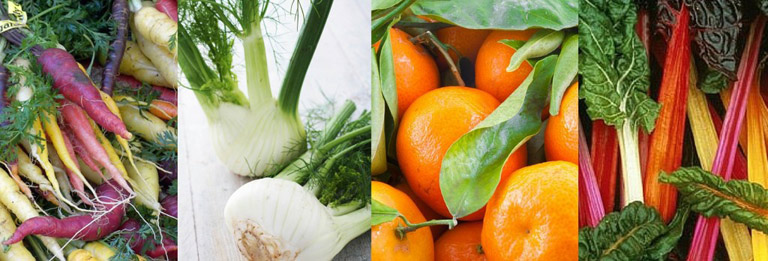I love following seasonal foods.
And, I try to fit a seasonal food article into the mix before each season
passes. Being it February, there are plenty of nutritionally wealthy fresh
foods that you can add to your February superfoods list the next time you
head to the store.
The key to incorporating a good balance of superfoods into your
diet is not to go crazy buying tons of trendy seeds and exotic juices with
flashy packaging, but to learn how to tap into natures own virtual
nutrition “power plant.” Yes, that is a pun, to make the point that
there are dozens of nutritionally awesome plant based foods out there that
you might already be eating every day, or that are sitting right under your
nose at the market.
A Superfoods List of Some Easy To Find Winter
Foods
The word “superfood” is actually a marketing word, and
not really scientific at all when it comes to nutrition, as explained in this
Wikipedia
link. So why do I use the word? For one thing, to get you to read
this article. Ha! See I am even on the wagon. But seriously, I understand
what you are really looking for when you pay attention to the word
“superfood.” So, my goal is to teach you how to actually get all
those outstanding nutrients, instead of being taken for a ride by some food
manufacturer. The key is to shift your thinking from “I need a
specific product because it’s a superfood” to
“I get plenty of super foods in my natural, delicious,
seasonal diet every day.”
The fact is, many of the most common fruits and vegetables
that we all grew up eating can be considered a “superfood,” that
is more nutrient dense in some way. Here is a superfoods list for your
February grocery list that you can find at the market and enjoy right
now. See if fitting these into your menu every week makes a difference for
you.
1. Persimmons
Persimmons are an excellent winter fruit, with 120 calories
and zero grams of fat per servings. They are high in vitamin C
and A and also contain wondrous phytochemicals.
Persimmons are sodium and cholesterol free, and are
teaming with iron, fiber and calcium.
2. Root Vegetables
During the winter months, there are many root vegetables in season
including sweet potatoes, rutabaga, parsnips, turnips and beets. Root vegetables are
high in vitamins C, A and E and are excellent sources of folate and fiber.
They can easily be added to soups and stews, grated and cooked into pancakes
or latkes, or roasted with a touch of olive oil.
Carrots are a powerhouse of beta-carotene, which our bodies
convert to vitamin A. Vitamin A helps to protect us against infections and
reduce the duration of respiratory illnesses. Beta-carotene is a fat-soluble
compound, so it requires minimal amounts of fat to be absorbed. This is
a plus especially for people following a lower fat diet.
3. Fennel
Fennel is one of my favorite “under-acknowledged”
vegetables that is quite easy to grow and to come by. It’s an excellent
source of vitamin C, potassium and folate. Its mild licorice flavor is
excellent in salads and goes great with citrus, radishes, and onion. It
is also tasty in pasta sauces, chopped up in rice, or braised as a vegan main
course.
4. Brussels Sprouts
Brussel sprouts are at their peak from fall to mid-winter, so they
are just about on their way out now, but you can still find them at the
market. They are an excellent source of vitamin C and
antioxidants. Roasting them with high-quality olive oil and a
sprinkle of salt and pepper will help to retain their heart-healthy
nutrients. You can enjoy Brussels sprouts alone or mix with
cranberries, apples and walnuts for a delicious side dish. You can also grate
them for a raw salad.
5. Leafy Greens
Leafy greens are in abundance during the winter season. Kale,
collard greens and Swiss chard are good sources of iron and folate, as well
as other antioxidants. They are also a great alternative to dairy when
looking to boost your calcium level.
One thing I love to do is to add a couple handfuls of kale,
spinach or any leafy green, chopped up, to a soup, pasta sauce, stew, or stir
fry. If you add it just at the end of cooking and let it just wilt, it
retains many of its raw nutrients and makes a great nutrition boost for a hot
quick meal. I offer this tip in my meal plans offered on the Whole, Clean
& Green Challenge.
6. Citrus Fruits
Citrus fruit is at its best in the winter months. They are high in
vitamins A
and C, and fiber. People typically want to juice citrus, but
try to enjoy them in all their whole, raw, delicious glory by adding them to
salads, putting them into your snacks, or garnishing them on top of your dinner.
7.
Pomegranate
Rich in antioxidants, potassium
and vitamin C, and a good source of beta-carotene, pomegranate
seeds make an excellent topping for just about anything. I put them in
salads, sprinkle over roasted vegetables, sprinkle over mashed sweet
potatoes, add them to a morning smoothie, and even just keep a little bowl of
them at the desk to nibble on when it’s snack time.
8. Pumpkin
Pumpkin is not only high in carotenoids but contains more than 200
percent of our recommended daily intake of vitamin A. Pumpkin only has
49 calories per cup and can be prepared so many more ways than just the
familiar pumpkin pie. Try the Pumpkin,
Potato & Leek Soup sometime from my recipe blog.
You can learn more about how to make seasonal, whole superfoods
list a part of your regular healthy lifestyle in our Pure Plant-Based
community. Learn
more here!

